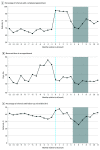Association of eConsult Implementation With Access to Specialist Care in a Large Urban Safety-Net System
- PMID: 35977310
- PMCID: PMC8796905
- DOI: 10.1001/jamahealthforum.2021.0456
Association of eConsult Implementation With Access to Specialist Care in a Large Urban Safety-Net System
Abstract
Importance: Accessing specialty care continues to be a persistent problem for patients who use safety-net health systems. To address this access barrier, hospital systems have begun to implement electronic referral systems using eConsults, which allow clinicians to submit referral requests to specialty clinics electronically and enable specialty reviewers to resolve referrals, if appropriate, through electronic dialogue without an in-person visit.
Objective: Measure the effect of implementing an eConsult program on access to specialty care.
Design setting and participants: Using an interrupted time series design with data from 2016 to 2020, this study analyzed 50 260 referral requests submitted during the year before and the year after eConsult implementation at 19 New York City Health + Hospitals (NYC H+H) specialty clinics that spanned 7 NYC H+H hospital facilities and 6 unique specialties.
Exposures: Referral request was submitted to a specialty clinic in the year following eConsult implementation.
Main outcomes and measures: Main outcomes included the fraction of referral requests resolved without an in-person visit following eConsult implementation; and, among requests triaged to have an in-person visit, the fraction of referrals with a successfully scheduled appointment, mean wait time to a specialty appointment, and the fraction of referral requests with a completed specialty visit. Changes associated with eConsult implementation were estimated using multivariate linear regression adjusting for patient age, gender, and specialty clinic fixed effects.
Results: Across 19 NYC H+H specialty clinics, 26 731 referral requests were submitted in the year before and 23 529 referrals were submitted in the year after eConsult implementation. Following eConsult implementation, 13% of all requests were resolved electronically. Among requests requiring a follow-up visit, the fraction with an appointment successfully scheduled increased by 15.8%, from 66.5% to 82.3% (P < .001). The mean time to an appointment decreased from 61.0 days pre-eConsult to 54.1 days post-eConsult, an adjusted 8.2-day shorter wait time (or 13.3% reduction) following eConsult adoption (P < .001). The percentage of referrals with a completed follow-up visit with a specialist within 90 days of the request did not change (38.4% vs 37.9%, P = .07). Changes in outcomes were mitigated during months when most clinics underwent an electronic health record transition after implementing eConsult.
Conclusions and relevance: In this quality improvement study, implementation of eConsults at a large multi-specialty safety-net system was associated with improvements in appointment scheduling rates and wait times. Despite an additional electronic health record transition, eConsults are a promising health care delivery tool for increasing access to specialty care.
Copyright 2021 Gaye M et al. JAMA Health Forum.
Conflict of interest statement
Conflict of Interest Disclosures: Dr Mehrotra reported grants from New York City Health + Hospitals during the conduct of the study. Dr Chokshi reported personal fees from Institute for Healthcare Improvement, personal fees from Aspen Institute, personal fees from RubiconMD, and personal fees from ASAPP, Inc, outside the submitted work. Dr Barnett reported grants from New York City Health + Hospitals. No other disclosures were reported.
Figures



Similar articles
-
Impact of an Opt-In eConsult Program on Primary Care Demand for Specialty Visits: Stepped-Wedge Cluster Randomized Implementation Study.J Gen Intern Med. 2020 Nov;35(Suppl 2):832-838. doi: 10.1007/s11606-020-06101-9. Epub 2020 Aug 10. J Gen Intern Med. 2020. PMID: 32779140 Free PMC article. Clinical Trial.
-
Primary Care Practitioners' Perceptions of Electronic Consult Systems: A Qualitative Analysis.JAMA Intern Med. 2018 Jun 1;178(6):782-789. doi: 10.1001/jamainternmed.2018.0738. JAMA Intern Med. 2018. PMID: 29801079 Free PMC article.
-
Improving the Referral Process, Timeliness, Effectiveness, and Equity of Access to Specialist Medical Services Through Electronic Consultation: Pilot Study.JMIR Med Inform. 2019 Jul 10;7(3):e13354. doi: 10.2196/13354. JMIR Med Inform. 2019. PMID: 31293239 Free PMC article.
-
The challenge of long waiting lists: how we implemented a GP referral system for non-urgent specialist' appointments at an Australian public hospital.BMC Health Serv Res. 2010 Nov 4;10:303. doi: 10.1186/1472-6963-10-303. BMC Health Serv Res. 2010. PMID: 21050488 Free PMC article. Review.
-
Key Components of Traditional Consultation Letters and Their Relevance to Electronic Consultation Replies: A Systematic Review.Telemed J E Health. 2020 Jun;26(6):689-699. doi: 10.1089/tmj.2019.0161. Epub 2019 Oct 9. Telemed J E Health. 2020. PMID: 31596680
Cited by
-
Improved access and care through the implementation of virtual Hallway, a consultation platform in Nova Scotia: preliminary findings from a feasibility evaluation.Implement Sci Commun. 2024 Oct 18;5(1):116. doi: 10.1186/s43058-024-00651-3. Implement Sci Commun. 2024. PMID: 39425232 Free PMC article.
-
From Clinic to Kitchen to Electronic Health Record: The Background and Process of Building a Culinary Medicine eConsult Service.J Multidiscip Healthc. 2024 Jun 7;17:2777-2787. doi: 10.2147/JMDH.S461377. eCollection 2024. J Multidiscip Healthc. 2024. PMID: 38863766 Free PMC article.
-
Classifying unstructured electronic consult messages to understand primary care physician specialty information needs.J Am Med Inform Assoc. 2022 Aug 16;29(9):1607-1617. doi: 10.1093/jamia/ocac092. J Am Med Inform Assoc. 2022. PMID: 35751571 Free PMC article.
-
A qualitative investigation of uninsured patient and primary care provider perspectives on specialty care eConsults.BMC Health Serv Res. 2023 Oct 20;23(1):1133. doi: 10.1186/s12913-023-10086-6. BMC Health Serv Res. 2023. PMID: 37864170 Free PMC article.
-
Impact of eConsults on Clinical Care in Primary Care: A Cross-Sectional Analysis of Primary Care Provider Behavior.J Prim Care Community Health. 2023 Jan-Dec;14:21501319231202201. doi: 10.1177/21501319231202201. J Prim Care Community Health. 2023. PMID: 37753619 Free PMC article.
References
Publication types
MeSH terms
LinkOut - more resources
Full Text Sources

